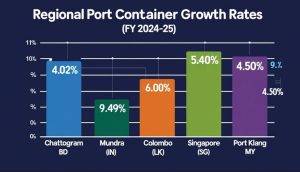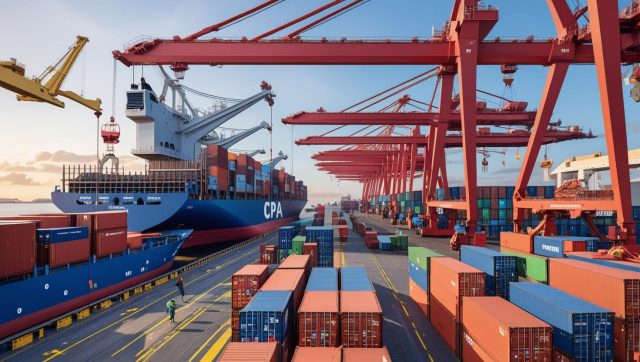From Our Correspondent, Chattogram: Chattogram seaport has set a new record in container handling during the just-concluded fiscal year 2024–25. A total of 3,296,067 TEUs (twenty-foot equivalent units) were handled at the port—the highest ever in Bangladesh’s maritime history. However, despite the record volume, the growth rate has slowed compared to the previous fiscal year.
In 2023–24, Chattogram Port handled 3,168,690 TEUs, meaning the year-on-year growth stood at 4.02 percent, down from 5.36 percent the year before. The net increase in container throughput was 127,377 TEUs.
Port officials noted that if operations had not been disrupted due to work stoppages and demonstrations by NBR officials in the latter part of the fiscal year, the total container handling might have crossed 3.3 million TEUs. According to shipping agents, global shipping disruptions, rising local logistics costs, and some persistent structural limitations contributed to the slower growth.
🌍 Regional Benchmarking
To understand the performance of Chattogram Port in context, it’s important to compare it with other key regional ports:
🇮🇳 India (Mundra, JNPT, Chennai):
Up to March of FY 2024–25, container handling at India’s major ports grew by 9.49%, according to the Ministry of Shipping. Mundra Port alone handled approximately 7.89 million TEUs, marking a significant increase.
🇱🇰 Sri Lanka (Colombo Port):
In 2023, Colombo Port handled nearly 7.5 million TEUs, with an estimated growth of 6.0% in 2024, according to the Sri Lanka Ports Authority.
🇸🇬 Singapore (PSA):
Singapore Port hit a new high with 41.12 million TEUs handled in 2024, registering 5.4% growth, as per the Maritime and Port Authority of Singapore.
🇲🇾 Malaysia (Port Klang, Tanjung Pelepas):
Malaysia’s major ports saw combined growth of around 4.5%, with Port Klang alone handling 14.64 million TEUs.

📉 Chattogram in Comparative Context
While Chattogram Port’s 4.02% growth in 2024–25 reflects resilience, it lags behind regional counterparts like India, Sri Lanka, and Singapore. Despite being the country’s primary trade gateway, Chattogram’s growth is hindered by infrastructure constraints, cargo release delays, and limited draft depth, which reduce its international competitiveness.
🗣️ Expert Opinion
Shipping and port economy experts emphasize that for Chattogram Port to sustain long-term growth, it must implement key strategic developments such as the construction of the Bay Terminal, deployment of modern container scanners, a fully digital gate pass system, and eventually a deep-sea port.











